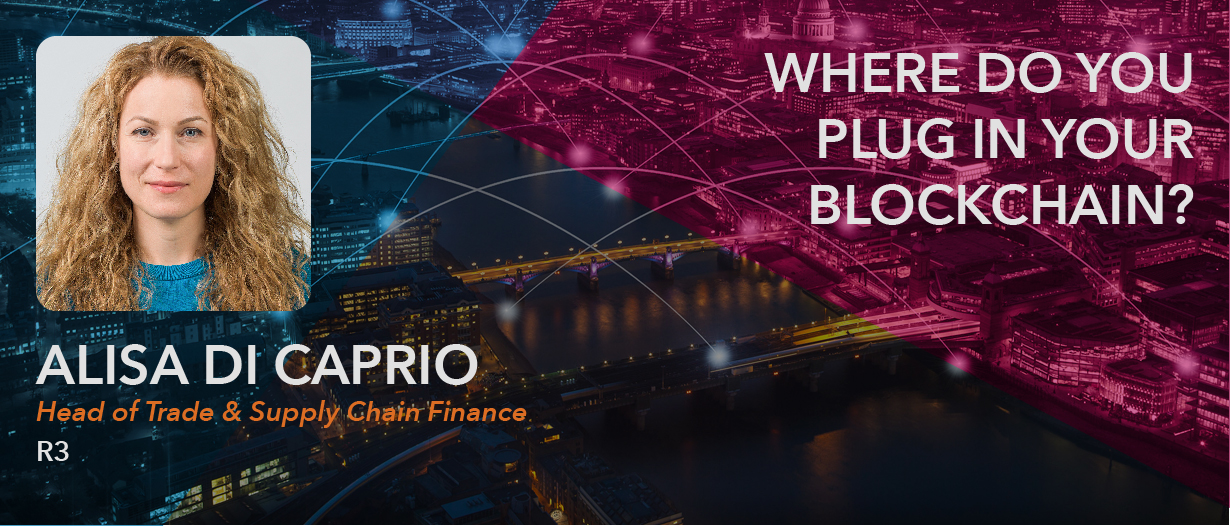So you’ve built yourself a blockchain, now what are you supposed to do with it?
Integrating the new technology into legacy systems is a key indicator for success. If you can bring the best of both the new and the old together to offer you optimal results, then the technology is serving its purpose. R3 has been doing this for the past twelve months, and it has led to some interesting insights that I would like to share.

Four different projects – Marco Polo, Voltron, RiskStream and Lendercomm – have used different strategies to ‘push’ and ‘pull’ back-office data. All of these have been developed over the past year and carry important implications for other blockchain solutions.
APIs are how blockchain talks to your system
The blockchain application you run talks to your legacy system using the same technology that you use today. You could use RESTful APIs, for example, to connect the data to your existing system of record.
In R3’s case, we have been building out our Remote Procedure Call (RPC) library of functions. This allows us to offer integrated options for existing legacy systems. Behind the scenes, the APIs that you create to connect your existing system to our Corda platform are ‘talking’ to the Corda RPC client, which then executes all the actions.
APIs are critical for users to access the full functionality of their blockchain application. They allow clients to push and pull data onto the blockchain. In other words, they allow users to select the data that truly adds value for them and fits their individual use case. The blockchain then adds the security of a distributed system and the immutability of data, among its other benefits.
ERP integration pulls data directly from your corporates
The problem trade finance applications face is how to make the experience seamless for the corporates that use it.
A large transnational corporate might have six different banking relationships that each require a bespoke connection from their Enterprise Resource Planning (ERP) back-office system to the bank’s platform, and then onto the bank’s own back-office system.
TradeIX’s project Marco Polo has built a native Oracle NetSuite App that directly pulls data from the Oracle NetSuite Cloud ERP system. For the corporate, that means that you continue to use your ERP as before, and instead of building another bespoke bridge; now you download the app which pulls data out directly. The Marco Polo ERP App is live today for Marco Polo’s receivable finance solution going live in the coming months.
Use your existing back office and industry providers
A second problem trade finance applications have is how to integrate with existing industry-wide tools and bank back-office systems.
Different blockchain applications have addressed hooks in different ways. In insurance, RiskStream Collaborative has built functionality that links into Guidewire, which is one of the two main systems to add efficiencies to all areas of risk management used in the insurance sector. This way, the blockchain solution, in this case, the “CorDapp”, pulls data about the claim using the inputs that insurance companies already produce.
Other projects are also pursuing this model – contracting with existing providers to build a different level of data integration, rather than moving to something altogether separate. Many of the major bank back-office providers are exploring how to do this now on business networks like Voltron.
Finastra’s Fusion Lendercomm will be used by agent banks for to automate the servicing required for syndicated lending. The app connects to Finastra’s existing on-premise solution Loan IQ for purposes of automating the information exchange between agent banks and leners. This means that re-platforming is minimal and the banks are simply reporting information as they were before through phone calls, faxes and e-mails in a digitize and automated fashion.
Enough about data, what about payments?
A final issue in blockchain and trade finance is payments. Obligations must be settled, either using digital currency or using traditional payment systems. Since on-ledger digital currency is in its infancy, most trade finance applications intend to settle obligations on traditional payment systems.
This is why R3 and SWIFT combined to integrate Corda to SWIFT net. This uses Corda Settler and SWIFT’s API gateway, gpi Link. Announced in January 2019, this integration allows users to create obligations and initiate and confirm settlement via the traditional correspondent banking system. Corda Settler allows two parties to create a contract that defines the amount, time, location, currency, and terms of payment. It requires an api connection to both initiate and – critically – confirm transaction completion. SWIFT gpi link provides that,
Like any piece of technology, blockchain will be most useful when used in conjunction with existing systems. The reality is that most businesses are not ‘digitally native’ and so will rely on legacy systems – all to different extents. The key to unlocking blockchain’s true potential is therefore not to try and oust these but to make sure blockchain fits into the right place.

































